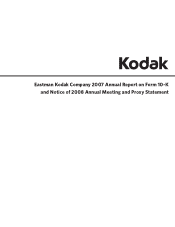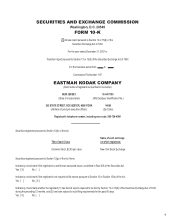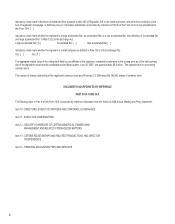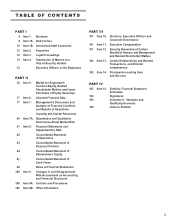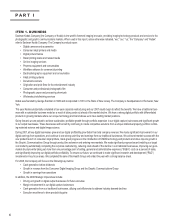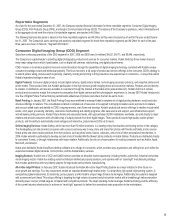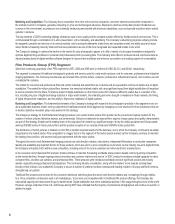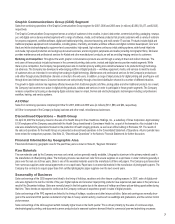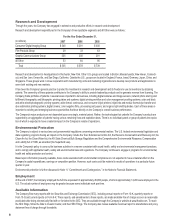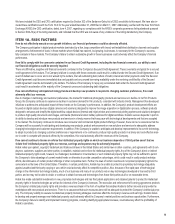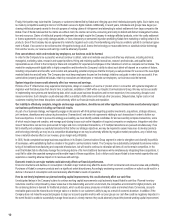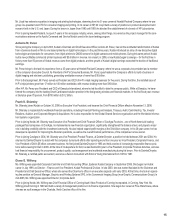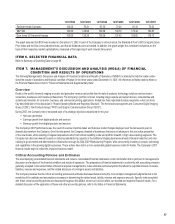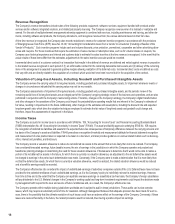Kodak 2007 Annual Report Download - page 10
Download and view the complete annual report
Please find page 10 of the 2007 Kodak annual report below. You can navigate through the pages in the report by either clicking on the pages listed below, or by using the keyword search tool below to find specific information within the annual report.9
We have included the CEO and CFO certifications required by Section 302 of the Sarbanes-Oxley Act of 2002 as exhibits to this report. We have also in-
cluded these certifications with the Form 10-K for the year ended December 31, 2006 filed on March 1, 2007. Additionally, we filed with the New York Stock
Exchange (NYSE) the CEO certification, dated June 4, 2007, regarding our compliance with the NYSE’s corporate governance listing standards pursuant
to Section 303A.12(a) of the listing standards, and indicated that the CEO was not aware of any violations of the listing standards by the Company.
ITEM 1A. RISK FACTORS
If we do not effectively execute on our growth initiatives, our financial performance could be adversely affected.
The Company participates in digital product markets dominated by a few, large competitors with broad, well-established distribution channels and supplier
arrangements. Achievement of scale, in those markets where Kodak has nascent, but growing, businesses, is necessary for the Company to success-
fully compete in these markets. The Company’s failure to obtain sustainable growth in these businesses could adversely affect the Company’s financial
performance.
If we fail to comply with the covenants contained in our Secured Credit Agreement, including the two financial covenants, our ability to meet
our financial obligations could be severely impaired.
There are affirmative, negative and financial covenants contained in the Company’s Secured Credit Agreement. These covenants are typical for a secured
credit agreement of this nature. The Company’s failure to comply with these covenants could result in a default under the Secured Credit Agreement. If an
event of default was to occur and is not waived by the lenders, then all outstanding debt, letters of credit, interest and other payments under the Secured
Credit Agreement could become immediately due and payable and any unused borrowing availability under the revolving credit facility of the Secured
Credit Agreement could be terminated by the lenders. The failure of the Company to repay any accelerated debt under the Secured Credit Agreement
could result in acceleration of the majority of the Company’s unsecured outstanding debt obligations.
If we cannot effectively anticipate technology trends and develop new products to respond to changing customer preferences, this could
adversely affect our revenues.
Due to changes in technology and customer preferences, the market for traditional photography products and services is in decline. In its Film Products
Group, the Company continues to experience declines in customer demand for film products, consistent with industry trends. Management has developed
initiatives to address the anticipated impact of these trends on the Company’s performance. In addition, the Company’s product development efforts are
focused on digital capture devices (digital cameras and scanners) designed to improve the image acquisition or digitalization process, software products
designed to enhance and simplify the digital workflow, output devices (thermal and inkjet printers and commercial printing systems and solutions) designed
to produce high quality documents and images, and media (thermal and silver halide) optimized for digital workflows. Kodak’s success depends in part on
its ability to develop and introduce new products and services in a timely manner that keep pace with technological developments and that are accepted
in the market. The Company continues to introduce new consumer and commercial digital product offerings. However, there can be no assurance that the
Company will be successful in anticipating and developing new products, product enhancements or new solutions and services to adequately address
changing technologies and customer requirements. In addition, if the Company is unable to anticipate and develop improvements to its current technology,
to adapt its products to changing customer preferences or requirements or to continue to produce high quality products in a timely and cost-effective man-
ner in order to compete with products offered by its competitors, this could adversely affect the revenues of the Company.
If we cannot continue to license or enforce the intellectual property rights on which our business depends or if third parties assert that we
violate their intellectual property rights our revenue, earnings and expenses may be adversely impacted.
Kodak relies upon patent, copyright, trademark and trade secret laws in the United States and similar laws in other countries, and agreements with its em-
ployees, customers, suppliers and other parties, to establish, maintain and enforce its intellectual property rights. Any of the Company’s direct or indirect
intellectual property rights could, however, be challenged, invalidated or circumvented, or such intellectual property rights may not be sufficient to permit
the Company to take advantage of current market trends or otherwise to provide competitive advantages, which could result in costly product redesign
efforts, discontinuance of certain product offerings or other competitive harm. Further, the laws of certain countries do not protect proprietary rights to the
same extent as the laws of the United States. Therefore, in certain jurisdictions, Kodak may be unable to protect its proprietary technology adequately
against unauthorized third party copying or use, which could adversely affect its competitive position. Also, because of the rapid pace of technological
change in the information technology industry, much of our business and many of our products rely on key technologies developed or licensed by third
parties, and we may not be able to obtain or continue to obtain licenses and technologies from these third parties at all or on reasonable terms.
Kodak has made substantial investments in new, proprietary technologies and has filed patent applications and obtained patents to protect its intellectual
property rights in these technologies as well as the interests of the Company’s licensees. The execution and enforcement of licensing agreements protects
the Company’s intellectual property rights and provides a revenue stream in the form of royalties that enables Kodak to further innovate and provide the
marketplace with new products and services. There is no assurance that such measures alone will be adequate to protect the Company’s intellectual prop-
erty. The Company’s ability to execute its intellectual property licensing strategies could also affect the Company’s revenue and earnings. Kodak’s failure
to develop and properly manage new intellectual property could adversely affect the Company’s market positions and business opportunities. Furthermore,
the Company’s failure to identify and implement licensing programs, including identifying appropriate licensees, could adversely affect the profitability of
Kodak’s operations.

